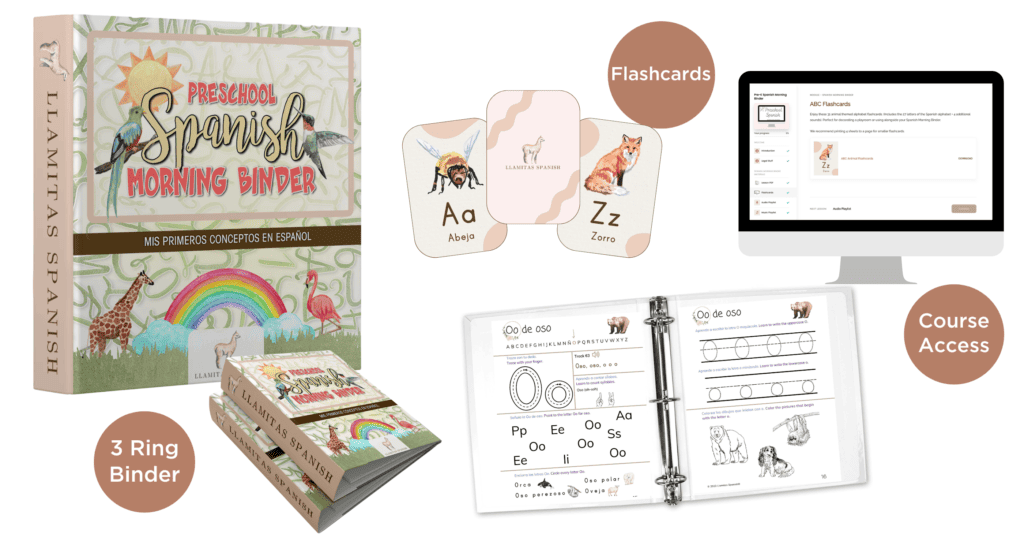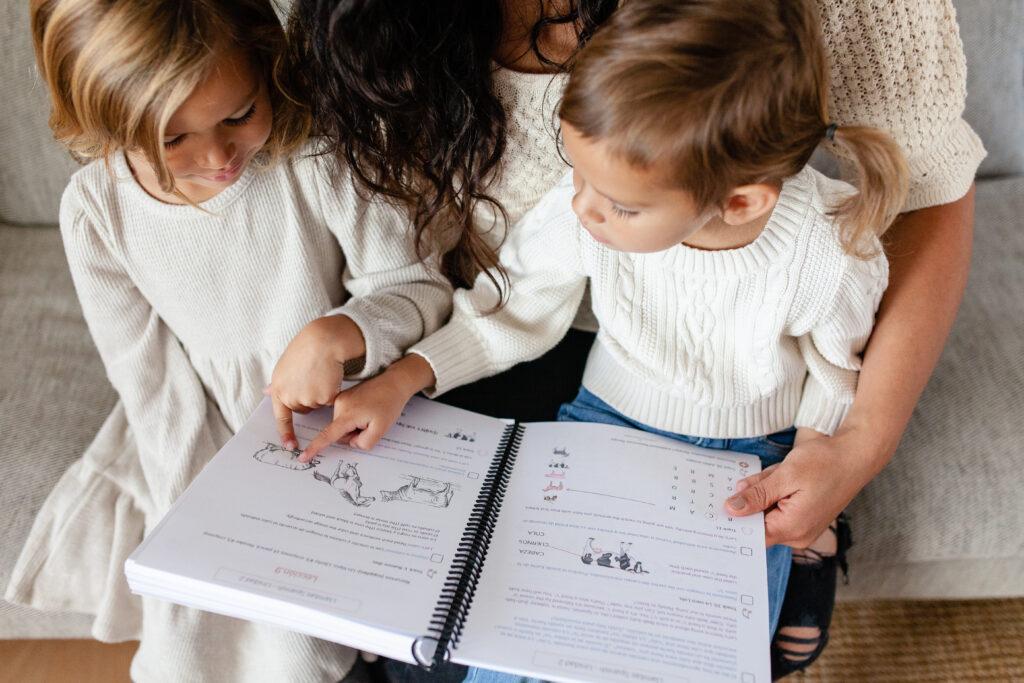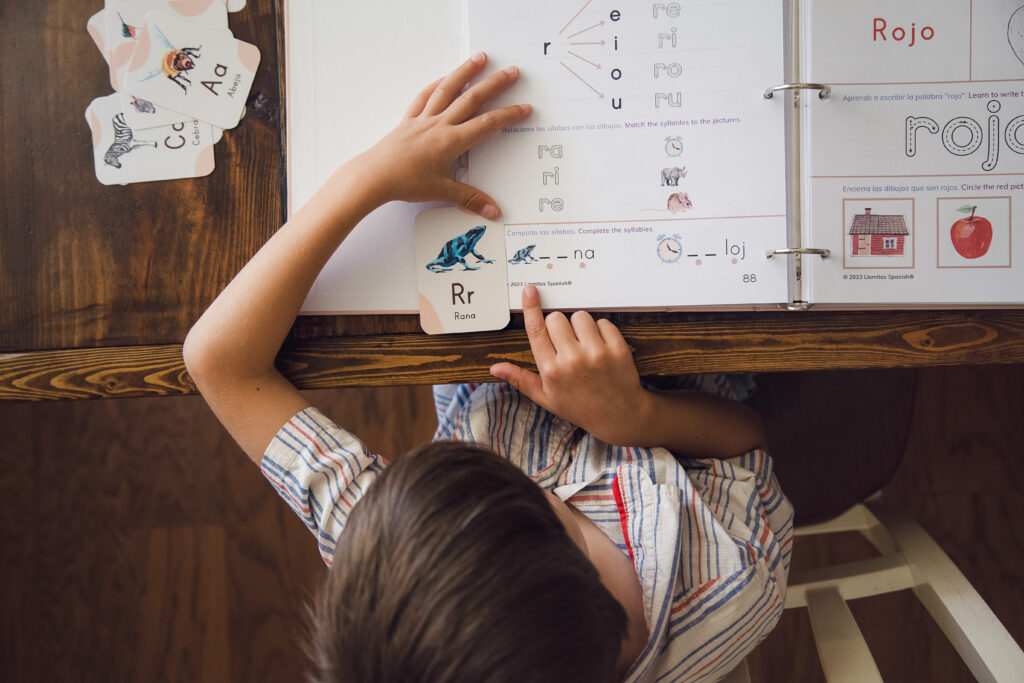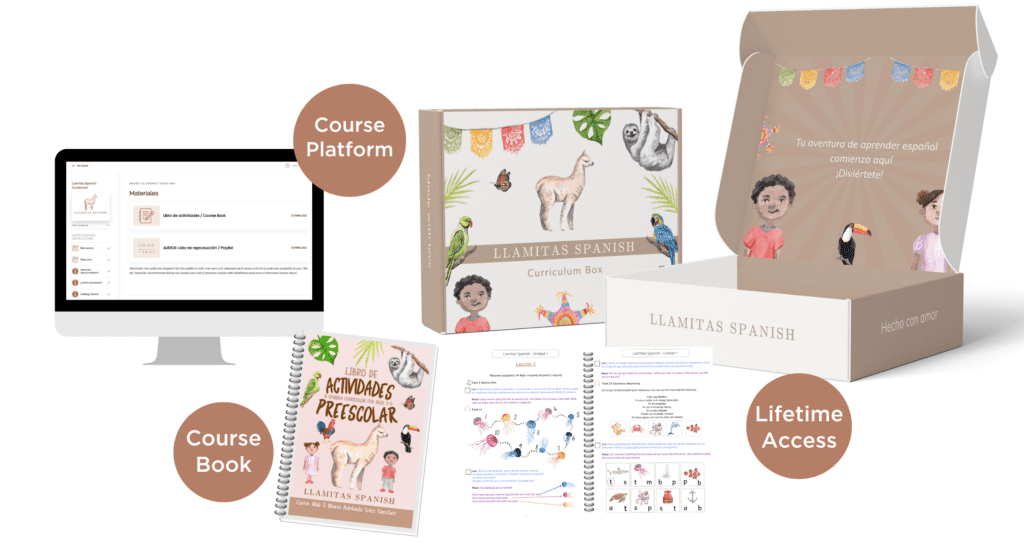In this post: A guide to Montessori Spanish language development, including toys and activities that promote language acquisition during the “sensitive period” (0-6 years).
Are you looking to support your child’s Spanish language acquisition in the early years?
The Montessori language development approach is particularly key for this “sensitive period” when your child has an absorbent mind. It allows children to work at their own pace and follow their unique interests when learning Spanish.

This post contains affiliate links. As an Amazon associate I earn from qualifying purchases.
At Llamitas Spanish®, we’ve adopted Montessori principles to support language development in the early years. Our curricula levels offer fun, interactive activities applied across subjects, which is essential for language learning in those early years.
Learn how you can apply Montessori methods to your Spanish lessons, along with activities and materials you can use to prepare your child’s learning environment and maximize their language development.
Related Post: How to Montessori at Home
Table of Contents
Individualized Instruction and Language Progression
If you aren’t yet familiar with the Montessori method, this is an alternative, student-led approach to education that allows children to pursue their unique interests. Teachers are seen more as guides in the classroom, supporting children as they progress at their own pace.
This education method was developed by Italian doctor and educator Maria Montessori in the late 19th and early 20th century. (If you don’t have experience with Montessori learning, you may find this article from Motherly helpful—it lays out 10 key principles of Montessori learning.)
Interestingly, you’ll find that Montessori classrooms often include a wider range of ages than a traditional school setting. For example, you might have 3–6 year olds together in one classroom.
If you were brought up with a traditional education, you might wonder how this works—won’t some kids fall behind or get bored?
In a Montessori education, children are given the freedom to explore the classroom and activities that they’re interested in, while the teacher moves around the classroom and works one-on-one with students.
This approach allows for individualized instruction, moving at the child’s pace.
Montessori believed strongly in hands-on learning and following a child’s natural curiosity. And research has found this approach to lead to better learning outcomes compared to a traditional education (Lillard & Else-Quest, 2006).
When it comes to language learning, the Montessori method has its own approach, too. While some stages in language acquisition develop naturally through exposure to language (think about how a baby learns their first words), others need to be taught.
The stages of language progression in the Montessori method are:
- Spoken Language: As you interact with your child—talking, reading, and singing songs—they naturally build their internal dictionary.
- Phonemic Awareness: Children begin to learn the alphabet and the sounds that go with each letter.
- Word Formation and Writing: With materials like a moveable alphabet, your child can begin to use their understanding of letter sounds to form words or “write” before they can even hold a pencil.
- Reading: Building on oral language skills, phonemic awareness, and writing skills, children begin to decode letters and sounds as they begin to read.
A fantastic guide for building these foundational skills is our Preschool Morning Binder. Beautifully illustrated activity sheets can be paired with flashcards, songs and art to learn first concepts.
What is the Montessori Way of Teaching Foreign Languages?
Teaching a foreign language in a Montessori environment may look a little different from what you’re used to. You won’t find kids drilling verb conjugation charts from a textbook in the Montessori classroom.
Instead, the Montessori approach to teaching foreign languages nurtures children’s natural curiosity, through:
- Movement. Kids love to move, and the Montessori method recognizes this. “Montessori foreign language teachers need to organize a learning environment that is abundant in concrete and authentic language materials that can be physically manipulated” (Jendza, 2016).
- Freedom of choice. Children are offered a variety of language materials that they can choose to use—or not use. It’s the teacher’s job to observe and find activities that kids are interested in, but not dictate what they do.
- Context. When language learning is connected to everyday life, it makes it interesting and important to kids. This is why thematic learning works so well for teaching Spanish to kids.
All of this can require some improvisation from the teacher, but that doesn’t mean it should be chaotic. You can plan ahead with a variety of materials and activities to choose from, using language labels, containers, and book corners, for example.
The Montessori method recognizes that language is interwoven with all aspects of learning. Language integrates with math, science, geography, and literacy, and the activities you choose can reflect that.
Related post: How to Set Up a Montessori Shelf
The Sensitive Period
The early years are such an important time for learning. Montessori recognized this and described sensitive periods that children go through from birth to age six, including a sensitive period for language.
We’ve all heard that kids’ brains are like sponges in those early years, and if you’re a parent, you’ll remember the “language explosion” your toddler went through when they learned their first words. From when they’re born up until around six years of age, your child is naturally acquiring language through their environment.
This sensitive period is a great time to introduce a foreign language! Recent research supports this idea, too, showing that learning a second language before the age of ten is ideal for fluency.
Related post: 10 Myths about Raising Bilingual Kids
Related post: How to Add a Foreign Language to Your Homeschooling

Writing Before Reading
You may have noticed that the Montessori stages of language progression put writing before reading. Early on, this isn’t writing in the traditional sense.
Once your child understands the basic sounds of Spanish, they can begin to use materials like a moveable alphabet or sandpaper letters to practice sounding out and forming words. Kids will come up with their own spelling based on letter sounds—called inventive or invented spelling.
Using a sand tray to practice writing is also common in Montessori classrooms. This way, your child can begin practicing their writing before they know how to hold a pencil.
These writing skills will help your child to naturally progress into reading, as they learn how letters work together to make words and phrases. Other skills are then developed in early elementary including classifying and alphabetizing, as well as grammar, such as antonyms and synonyms.
Related post: How to Montessori at Home
Popular Montessori Activities for Learning Spanish
As you begin to put together Montessori activities for learning Spanish, remember that you want to allow for movement, freedom of choice, and real-life application. A Montessori environment is hands-on and multi-sensory.
Include thoughtfully chosen toys and activities, label your shelves in Spanish, and keep things organized in containers so your child can easily choose what they’d like to do and put it away when they’re done.
So, what makes an activity Montessori?
Montessori activities target one skill and have a beginning, middle, and end.
Kids toys often have multiple skills involved, like pushing, noises, flashy lights, and pressing buttons. Montessori activities, on the other hand, allow the child to master one skill at a time—like placing a ball through a hole or matching animal figurines to pictures.
There are SIX total categories which a toy should fall into in order to encourage child development:
- Hand-Eye Coordination
- Music
- Movement
- Arts and Crafts
- Language
- Practical Life
The recommendations below focus on category 5: LANGUAGE development.
Miniature Language Objects
These are essentially small replicas of realistic objects of living things.
The first step would be to place real or replica objects in a basket (classified by theme: animals, fruit, etc). These are 3D objects that the child is able to pick up and study. By repeating the name of the object the child will build association.
Once this is mastered, the child is then ready to do the same with 2D objects, such as flashcards or photographs. One great idea given in The Montessori Toddler is to have the child match those 3D objects to a corresponding 2D picture.
Literacy
Read aloud often. This is honestly the most important and powerful thing you can do when your child is in this sensitive period for language development.
Children love to read books that have meaning for them—things they can relate to, like books about family, colors, weather, food, or daily routines. Having a book corner filled with Spanish picture books is so helpful.
Here are our top tips for choosing Spanish children’s books:
- Choose books that have beautiful illustrations and reflect reality.
- Choose books that have just one or two sentences per page—any more can be overwhelming.
- Choose a selection of interactive books, board books, picture books, and musical books.
- Choose books that reflect diversity: different races, nationalities, etc.—we want to raise global citizens!
You can shop our PaperPie bilingual bookstore for more titles!

Related Post: Children’s Spanish Books for Beginners
Imaginative Play
While Montessori classrooms often discourage fantasy play—for instance, superpowers, mythical creatures, or magic—realistic pretend play is another story.
Kids love to mimic real-life activities, and it’s an important part of how they learn about the world.
This can be a helpful tool in teaching themed Spanish vocabulary, much like with miniature language objects. For example, play kitchens and toy food can offer lots of opportunities for practicing new Spanish words around food.
Alphabet Recognition
Again, the Montessori method teaches writing before reading—this allows the child to experience the letter (see it, feel it, make it) which supports reading later.
Here are two of our favorite Montessori-inspired tools for alphabet recognition:
- Sandpaper letters: This is perfect for 3 and up. It’s designed to guide the hand for writing, and comes with wooden storage boxes. Allow your child to see the letter and trace it with their fingers while you sound it out.
- Wooden movable alphabet: This is a great option for learning to spell. Rather than erasing, kids can practice with movable letters. You can also practice matching pictures (flashcards) to words.
Although these are designed for English, they can still be a useful tool for teaching the Spanish alphabet!
Our Llamitas Spanish® Preschool Morning Binder is another fantastic option for introducing your child to the Spanish alphabet. This gentle introduction to Spanish includes animal-themed ABC flashcards and 180+ printables with tracing and letter recognition opportunities.
Imaginative Play
This is somewhat of a controversial topic for Montessori. However, it is important to provide opportunities for children to use their imagination and encourage creativity. By mimicking real-life activities children are able to practice the vocabulary they have acquired and develop fine motor skills.
Learning to care for dolls, in particular, builds socio-emotional skills and some of our favorites are these gorgeous anatomically correct Minikane dolls.
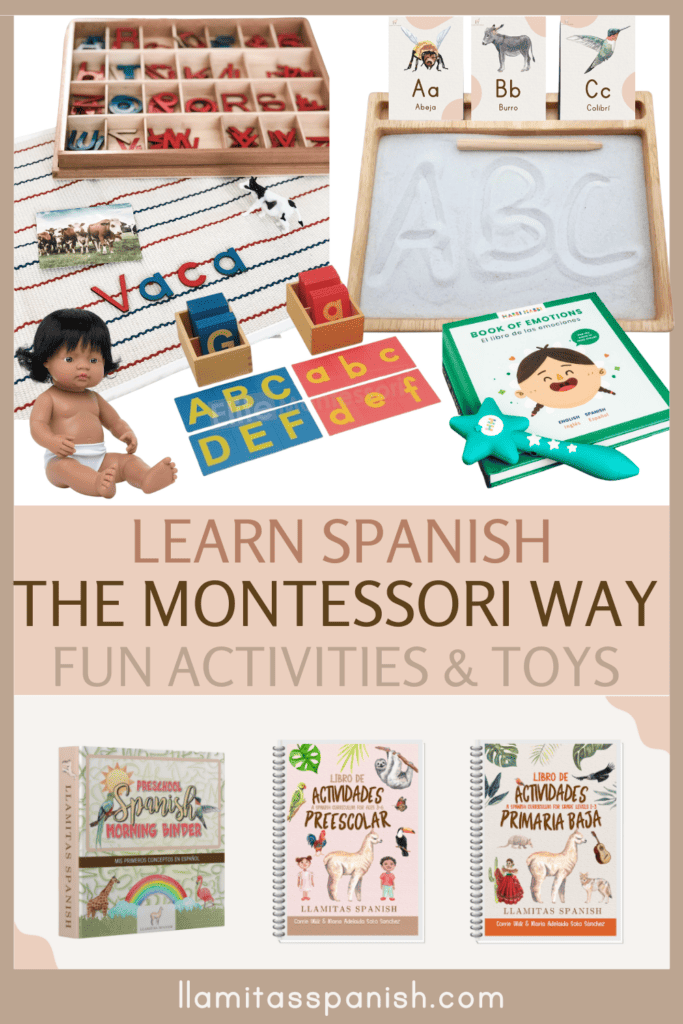
Llamitas Spanish Early Years Curriculum
The Llamitas Spanish® Early Years Curriculum has adopted many of these Montessori principles, making it a perfect foreign language addition to any Montessori-inspired education. This done-for-you program teaches both written and spoken Spanish in context with thematic lessons.
Our Level 1 Curriculum is a full-year, open & go Spanish curriculum designed for the early years. It uses playful songs, poetry, and stories to make lessons fun and interactive for young kids.
We’ve included 3-part Montessori flashcards to support students in learning unit vocabulary. If you aren’t familiar with these, they consist of a labeled picture card, a label card, and a picture card—a staple in Montessori classrooms!
Lessons also include plenty of movement and music, with over 30 authentic nursery rhymes, games, and other activities designed with young learners in mind.
As with the Montessori method, at Llamitas Spanish® we understand the importance of applying Spanish across subjects, which is why our curriculum takes a thematic approach. We include specialized nomenclature vocabulary in every unit—from farm animals to community helpers.
The best part is that everything is done for you, whether you speak Spanish already or are learning alongside your child. Let us do the hard work for you!

